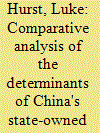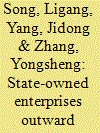|
|
|
Sort Order |
|
|
|
Items / Page
|
|
|
|
|
|
|
| Srl | Item |
| 1 |
ID:
109906


|
|
|
|
|
| Publication |
2012.
|
| Summary/Abstract |
This paper provides original evidence about Chinese Outward Direct Investments in Italy. Data have been collected at the micro level, through a multiple-choice questionnaire, designed by the author and submitted to the whole population of Dragon multinationals. With a response rate of 86%, we draw a detailed profile of Chinese parent companies and document their pull, push factors, and entry mode strategies. Empirical findings are consistent with the theoretical literature.
|
|
|
|
|
|
|
|
|
|
|
|
|
|
|
|
| 2 |
ID:
106008


|
|
|
|
|
| Publication |
2011.
|
| Summary/Abstract |
Chinese outward direct investment (ODI) appears to differ from that of advanced economies. Is there a unique China model? By reviewing industry distributions of ODI data for 2003-2009, we found that Chinese ODI was not concentrated in industries that performed well either in exporting or domestically. Statistical analyses also confirmed that traditional variables, such as market size, production cost and legal environment, did not impact Chinese investors' choice of location for ODI. Instead, investors selected places where they could either learn advanced technologies or secure stable commodity supplies. We have tentatively concluded that the main purpose of the China model of ODI has not been to expand production overseas but to strengthen industries at home.
|
|
|
|
|
|
|
|
|
|
|
|
|
|
|
|
| 3 |
ID:
106012


|
|
|
|
|
| Publication |
2011.
|
| Summary/Abstract |
Chinese outward direct investment (ODI) is expanding at an unprecedented rate. The present study augments the understanding of the determinants and drivers of Chinese ODI. It reviews the literature on Chinese ODI and analyzes investment by state-owned enterprises (SOE) for the period 2003-2008, focusing specifically on the differences between the determinants of Chinese investment in developed (OECD) and developing (non-OECD) economies. In addition, the study assesses the appropriateness of the general framework used for investigating ODI determinants (Dunning's eclectic paradigm) to analyze the experience of Chinese SOE. The findings indicate that Dunning's eclectic paradigm provides an excellent theoretical framework for analyzing the determinants of Chinese SOE investment in developed countries, and provides a good starting point for analysis of Chinese investment in developing countries. However, Dunning's specification requires refinement for developing countries. This paper finds a distinct difference between the motivations for Chinese SOE investment in developed and developing countries.
|
|
|
|
|
|
|
|
|
|
|
|
|
|
|
|
| 4 |
ID:
141703


|
|
|
|
|
| Summary/Abstract |
During the past decade, China's outward direct investment (ODI) and exports have experienced rapid growth, drawing increasing attention to the relationship between them. Using the gravity model based on panel data on China's ODI and trade to 174 countries and regions during 2003–2012, the present paper investigates the impacts of China's ODI on exports. We find that China's ODI to a host country significantly promotes China's trade with that economy: a 10-percent increase in ODI stock can lead to a 2.14-percent increase in exports, a 2.07-percent increase in imports and a 2.87-percent increase in net exports. The scale of the host country's economy, its infrastructure and its distance to China also have significant impacts on China's exports. Therefore, growth in ODI will facilitate China's trade and integration into the global economy, and enhance industrial upgrading in China by transferring the low-end industries abroad.
|
|
|
|
|
|
|
|
|
|
|
|
|
|
|
|
| 5 |
ID:
120841


|
|
|
|
|
| Publication |
2013.
|
| Summary/Abstract |
The build-up of huge foreign exchange reserve makes China a net creditor and also brings in significant challenges to the Chinese economy. Considering the internationalization of the renminbi as China's response to the global imbalance, this paper analyzes the effect of renminbi internationalization on the formation of reserves and compares its benefits and costs in rebalancing China's external position with those of outward direct investment. It assesses the current progress in the practice of using the renminbi in cross-border trade settlement and in the development of the offshore renminbi market. It further examines the possibility of the renminbi serving as a global reserve currency in the future.
|
|
|
|
|
|
|
|
|
|
|
|
|
|
|
|
| 6 |
ID:
106010


|
|
|
|
|
| Publication |
2011.
|
| Summary/Abstract |
Since China's accession to the WTO in 2001, China has been on a steep learning curve in terms of engaging in outward direct investment, and state-owned enterprises (SOEs) have played a predominant role in this drive. We argue that investment overseas by SOEs is a double-edged sword as far as its impact on domestic reform is concerned. Investing overseas offers opportunities to deepen structural reform in China, but such investment could also strengthen the monopoly position of some SOEs, which is inconsistent with the objective of domestic reform. Therefore, it is important for China to deepen domestic reform with respect to competition, ownership and regulations, to maximize the benefits from investing overseas. The present paper also discusses how building market-compatible institutions will result in increased innovation. This provides opportunities for Chinese firms to effectively catch up with the advanced technologies to remain competitive in overseas markets.
|
|
|
|
|
|
|
|
|
|
|
|
|
|
|
|
| 7 |
ID:
143432


|
|
|
|
|
| Summary/Abstract |
The present study uses firm survey data of 1033 manufacturing firms operating in Ethiopia in 2011 to examine the impact of Chinese outbound direct investment on the productivity of domestic firms. Particularly, we attempt to answer two questions. Firstly, are Chinese-owned (henceforth foreign) firms more productive than local ones? Secondly, does the presence of foreign firms generate technology spillovers on domestic firms operating in the same industry? Our empirical results show that foreign firms are more productive and that their presence has different spillover effects on the productivity of domestic firms. In particular, we find that domestic firms with higher absorptive capacity experience positive spillovers, while those with low absorptive capacity witness negative spillover. We also find that small firms and non-exporting firms benefit more from spillovers than do other types of domestic firms. In this study, instrumental variables are used to address the potential endogeneity between foreign firm presence and domestic firm productivity.
|
|
|
|
|
|
|
|
|
|
|
|
|
|
|
|
|
|
|
|
|